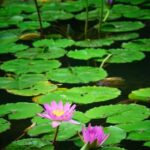A shade garden presents a unique opportunity to create a beautiful and tranquil outdoor space that thrives in low-light conditions. In this article, we will explore the world of shade garden landscaping and provide you with a variety of ideas for designing, planting, and maintaining a stunning shaded garden. Whether you’re working with a small shaded area or an extensive woodland landscape, you’ll find inspiration for creating a vibrant and lively atmosphere in your outdoor space.
When it comes to landscaping in shaded areas, there are many factors to consider, including plant selection, layout design, adding color, incorporating hardscaping elements, maintaining the garden’s health, and enhancing the atmosphere with accessories. In this section, we will delve into the importance of landscaping in shaded areas and what makes these spaces unique.
From understanding what a shade garden is to highlighting the significance of utilizing different levels and textures for a dynamic look, we will set the stage for creating your own stunning shaded paradise. So whether you’re starting from scratch or looking to renovate an existing shade garden landscape, get ready to be inspired by our collection of ideas and tips for transforming your outdoor space into an oasis of beauty.
Choosing the Right Plants for a Shade Garden Landscape
A shade garden landscape can be a beautiful and serene addition to any outdoor space, but it does require some careful planning and consideration when it comes to choosing the right plants. Unlike traditional gardens that receive ample sunlight, shaded gardens present unique challenges when it comes to plant selection. However, with the right knowledge and plant choices, you can create a lush and thriving garden in even the shadiest of areas.
When selecting plants for a shade garden landscape, it’s important to focus on species that are well-suited to low-light conditions. Some popular options include ferns, hostas, and coral bells, all of which are known for their ability to thrive in shady environments. These plants not only tolerate shade well but also bring a variety of textures and colors to the garden, adding visual interest without relying on sunlight.
In addition to choosing plants that are naturally suited to shade, there are also several tips for selecting the right plants for a shaded area. Look for native species that are adapted to your specific climate and growing conditions.
Consider the mature size of each plant and ensure that they will not overcrowd or overshadow one another as they grow. Finally, think about creating layers in your garden by incorporating plants of varying heights and shapes, which adds depth and dimension to the overall landscape.
| Shade Garden Plant | Description |
|---|---|
| Ferns | These non-flowering plants come in a variety of sizes and shapes, adding lush greenery to any shaded area. |
| Hostas | Known for their large leaves and wide array of colors, hostas are a popular choice for shaded gardens. |
| Coral Bells | Also called heucheras, these perennials offer colorful foliage in shades of green, purple, or red. |
Designing the Layout of a Shade Garden Landscape
Ideas for Creating Visual Appeal
One way to design a visually appealing layout for a shade garden is to utilize different levels and textures. Incorporating plants of varying heights and foliage types can add depth and interest to the space. Consider using taller plants as focal points or to create a backdrop, while lower-growing plants can be used to fill in the foreground. Additionally, mixing different textures such as smooth leaves, fern-like foliage, and spiky flowers can contribute to an engaging visual experience.
Utilizing Shaded Areas Effectively
Incorporating different elements such as pathways, seating areas, or decorative features can make the most of shaded areas in a garden. For example, placing a bench or small seating area in a particularly shady spot can create a cozy nook for relaxation or contemplation. Additionally, adding meandering pathways that wind through different shaded areas can encourage exploration and discovery within the garden.
Creating Functional Spaces
When designing the layout of a shade garden landscape, it’s important to consider how the space will be used. If the shaded area is intended for entertaining or socializing, creating open spaces with seating arrangements may be ideal. Alternatively, if the shaded garden is meant for peaceful reflection, incorporating secluded alcoves or quiet corners can provide retreats from the hustle and bustle of daily life.
By incorporating these ideas into your shade garden landscape design, you can create an inviting and visually captivating outdoor space that makes the most of its unique lighting conditions. Whether you’re looking to entertain guests or simply enjoy some quiet time surrounded by nature, thoughtful layout design can enhance the overall ambiance of your shaded garden.
Adding Color to a Shade Garden Landscape
When it comes to designing a shade garden landscape, many people often think of dull and gloomy areas. However, with the right selection of plants, it is possible to add vibrant pops of color to brighten up any shaded garden space. Here are some suggestions for adding color to a shade garden landscape:
1. Colorful Foliage: Opt for plants that have striking foliage colors such as deep purples, bold greens, or variegated patterns. Some great options include hostas, coleus, heuchera, and ferns. These plants not only add visual interest but also thrive in low-light conditions.
2. Shade-Loving Flowers: There are plenty of flowers that bloom beautifully even in shaded areas. Consider planting varieties such as astilbe, impatiens, begonias, and bleeding hearts to introduce bright hues to your shade garden landscape.
3. Varied Textures: Incorporate plants with different textures to create depth and dimension in your shade garden. Mix in leafy plants with smooth petals and spiky foliage for an interesting visual appeal.
For a lively and inviting atmosphere in a shaded garden area, adding colorful foliage and flowers is essential. By carefully selecting the right plants with vibrant hues and diverse textures, you can create a stunning display of colors even in the most shaded spots.
Incorporating Hardscaping Elements in a Shade Garden Landscape
When it comes to creating a shade garden landscape, incorporating hardscaping elements can add functionality and visual interest to the space. One of the key ideas for adding hardscaping elements to a shade garden is to ensure that they complement the natural beauty of the area without overshadowing it. This can be achieved by using natural materials such as stone, gravel, or wood that blend seamlessly with the surroundings.
Paths and walkways are important hardscape features in any garden, including shade gardens. In a shaded environment, consider using materials that stand out against the foliage, such as light-colored gravel or stepping stones. These elements not only provide practical access throughout the garden but also serve as an opportunity to add texture and visual appeal.
Another great idea for incorporating hardscaping elements in a shade garden landscape is to create seating areas. Whether it’s a simple bench nestled under a canopy of trees or a small patio tucked away in a shaded corner, these spaces provide opportunities for relaxation and contemplation within the tranquil atmosphere of a shade garden landscape.
Moreover, decorative accents like birdbaths, sculptures, or even lighting fixtures can enhance the ambiance of a shade garden. These elements can add personality and charm to the space while staying true to the overall natural aesthetic. When adding these features, it’s important to consider placement and scale in order to maintain balance and harmony within the landscape.
| Shade Garden Hardscaping Tips | Data |
|---|---|
| Incorporate natural materials | Use materials such as stone or wood that blend seamlessly with the surroundings |
| Create pathways with visual appeal | Consider using light-colored gravel or stepping stones for added texture |
| Add functionality with seating areas | Create spaces for relaxation that fit within the tranquil atmosphere of a shade garden landscape |
Maintaining a Shade Garden Landscape
A shade garden landscape offers unique challenges when it comes to maintenance, but with the right approach, you can keep your shaded oasis looking lush and beautiful. Here are some essential tips for tending to your shade garden:
1. Proper Watering: Since shaded areas tend to retain moisture and may not receive as much direct sunlight, it’s important to monitor the moisture levels of the soil in your shade garden. Consider using a moisture meter to ensure that your plants are receiving adequate water without becoming waterlogged.
2. Pruning and Trimming: Regular pruning is essential for maintaining the health and appearance of plants in a shade garden landscape. Keep an eye out for any signs of disease or overgrowth, and trim accordingly. Additionally, removing any dead or yellowing leaves can help keep your garden looking tidy and vibrant.
3. Fertilizing: Because shaded gardens often have nutrient-rich soil from leaf litter and organic matter, they may not require as much fertilizer as sunnier gardens. However, it’s still important to feed your plants with a balanced fertilizer according to their specific needs.
4. Pest Control: Keep an eye out for common pests that may affect shade-loving plants, such as slugs and snails. Implement natural pest control methods such as diatomaceous earth or copper barriers to protect your plants without harming the environment.
By following these maintenance tips, you can ensure that your shade garden landscape continues to thrive and flourish for years to come.
Enhancing the Atmosphere With Shade Garden Accessories
A well-designed shade garden can be a peaceful and inviting retreat, but adding the right accessories can take it to the next level. By incorporating decorative elements such as statues, fountains, and lighting, you can enhance the overall atmosphere of your shaded garden space.
Suggestions for Shade Garden Accessories
When it comes to choosing accessories for your shade garden landscape, consider elements that will complement the natural beauty of the space. Statues and sculptures can add a touch of elegance and whimsy, while a gently bubbling fountain can create a soothing ambiance. Additionally, strategically placed lighting can accentuate certain areas of your garden, creating visual interest and extending its usability into the evening hours.
Tips for Creating an Inviting Atmosphere
To ensure that your shade garden is as inviting as possible, it’s important to select accessories that reflect your personal style and create a tranquil atmosphere. Consider incorporating seating areas where you can relax and unwind surrounded by lush greenery. Additionally, adding bird feeders or houses can attract wildlife and bring even more life to your shaded garden space.
Creating Tranquil and Inviting Atmosphere
When selecting accessories for your shade garden landscape, aim to create a tranquil and inviting atmosphere where you and your guests can feel at ease. Avoid cluttering the space with too many elements, instead opting for a few carefully chosen pieces that will enhance the natural beauty of the area.
By selecting accessories that align with the overall aesthetic of your shaded garden, you’ll be able to create a harmonious and relaxing atmosphere in which to enjoy nature’s beauty.
Real-Life Shade Garden Landscape Ideas
In conclusion, creating a beautiful and thriving shade garden landscape is not only achievable but also incredibly rewarding. By carefully selecting the right plants, designing an appealing layout, adding vibrant colors, incorporating hardscaping elements, maintaining the garden, and enhancing the atmosphere with accessories, you can transform any shaded area into a stunning outdoor retreat. The key is to embrace the unique characteristics of shade gardens and use them to your advantage when planning and executing your landscaping project.
One of the most crucial factors in achieving success with shade garden landscape ideas is choosing the right plants. With careful consideration and research, you can create a lush and diverse plant palette that will thrive in low-light conditions. Additionally, focusing on textures, levels, and hardscaping elements will add dimension and visual interest to your shade garden landscape.
Furthermore, real-life shade garden landscape examples offer valuable inspiration for those looking to embark on their own shade garden projects. By studying these showcased landscapes with photos and descriptions, you can gain insight into how different design elements come together to create stunning outdoor spaces. These real-life examples provide practical guidance on how to implement various shade garden landscape ideas while allowing for personal creativity and interpretation.
Frequently Asked Questions
How Do You Landscape a Shade Garden?
Landscaping a shade garden requires careful selection of plants that thrive in low light conditions. This can include shade-loving perennials such as hostas, ferns, and astilbes, as well as shade-tolerant shrubs like hydrangeas and rhododendrons.
Incorporating different textures and leaf shapes can add visual interest to the space. Additionally, including elements like mulch, rocks, or even a small water feature can enhance the overall design of a shaded garden area.
What Can I Grow in Shaded Garden Area?
In a shaded garden area, there are several options for what to grow. Shade-tolerant plants such as impatiens, begonias, and coleus are popular choices for adding color to these areas.
Various types of foliage plants like caladiums or heucheras can also thrive in shaded conditions. For larger plants or ground cover options, consider looking into options like lady ferns, hostas, or even certain species of moss.
What Should Be in the Shaded Area of a Garden?
When designing the shaded area of a garden, it’s important to consider both aesthetic and practical elements. Shade-loving plants are essential to ensure the success of the garden space.
Beyond just plants, incorporating seating areas or pathways can create an inviting atmosphere for enjoying the shaded environment. Additionally, adding features like bird feeders or wind chimes can enhance the sensory experience within this part of the garden.

Welcome to my gardening blog! I am passionate about plants and enjoy sharing my knowledge and experiences with others. In this blog, I will write about everything related to gardening, from tips on how to get started to updates on my own garden projects.





